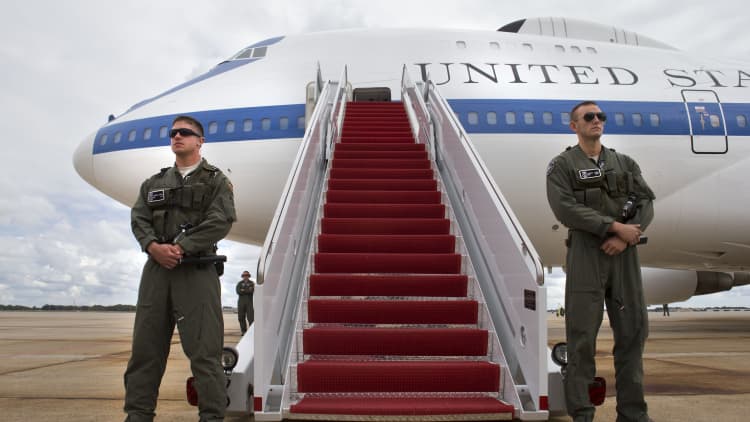ABOARD A US MILITARY AIRCRAFT — There is no aircraft quite like the U.S. Air Force's E-4B.
Affectionately known as the "doomsday plane," the modified Boeing 747 is used to transport the secretary of Defense and is born and bred for battle. It stands nearly six stories tall, is equipped with four colossal engines, and is capable of enduring the immediate aftermath of a nuclear detonation.
"It's like a backup Pentagon," a U.S. Air Force crew member told CNBC aboard one of the aircraft. "There's always one plane on alert and ready to go 24 hours, seven days a week."
On Tuesday morning, acting Secretary of Defense Patrick Shanahan boarded the E-4B at Joint Base Andrews in Maryland for a week-long trip to Asia. It was his second time taking the plane on an international trip since ascending to the highest office in the Pentagon. The aircraft, also known as the National Airborne Operations Center, will ferry Shanahan and his staff to Hawaii, Indonesia, Singapore, South Korea and Japan.
Air crew aboard the plane said that the aircraft would clock a total of 22,538 nautical miles with the help of three aerial refuelings and six tankers during the eight-day trip.
"It's great, but they keep giving me more work," Shanahan joked when asked about working and traveling on the E-4B. "The work never stops," he added, noting that he has a pulse on U.S. military operations across the globe while aboard the aircraft.
"Think of it as this, the plane is basically a flying command center,” a Pentagon spokesman said aboard the aircraft. The spokesman added that the secretary has access to both unclassified and the highest form of classified communication systems on the plane. "So, he's never out of the loop," another Pentagon spokesman added.

Much like Air Force One, its sister aircraft with the same recognizable paint job, most of the E-4B's capabilities are classified.
Currently, there are four of these unique aircraft in the Air Force's fleet. The identical planes, which are based at Offutt Air Force Base in Nebraska, have been in operation since 1980.
The noticeable hump on top of the plane is called a "radome" and houses some of the nearly 67 different satellite dishes and antennas. The dome is one element in the E-4B's communication portfolio that gives those aboard the ability to contact ships, submarines, aircraft and landlines anywhere in the world.
What's more, thanks to aerial refueling and the E-4B's massive fuel tanks, the plane can stay aloft for several days. The three-deck aircraft can support a crew of up to 112 people. It has 18 bunks, six bathrooms, a galley, briefing room, conference room, battle staff work area and executive quarters.
Unlike Air Force One, the E-4B is built for utility, and its interior is dated and nearly windowless. With a few exceptions, the plane's electronics and flight instruments are also antiquated.
"It's a common misconception, but this plane doesn't have digital touch screens in the cockpit or elsewhere," explained another crew member. "The conditions that this plane is meant to fly in call for analog, since digital tech would fry during a nuclear war," he added.
In other words, the E-4B's analog technology is less susceptible to the electromagnetic pulse that follows a nuclear blast. The aircraft are slated to have reached their service life by 2039.


